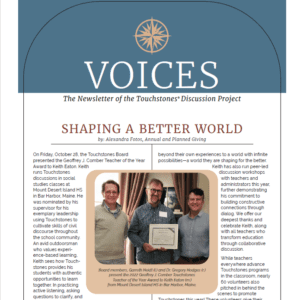An Interview With Howard Zeiderman
I understand you’re getting ready to release the newest Touchstones program volume. Tell me a little about it.
This program, called Completing the Odyssey, helps returning veterans in their transition home after service. The title is a reference to Homer’s Odyssey, in which the main character struggles for 10 years after battle to return home. In the story, Odysseus is told by a prophet that even once he returns to his kingdom of Ithaca, he will have to leave again. He will have to make yet one more journey before he can claim Ithaca as his home. I understand this second journey to be figurative—and it’s one that distinguishes between returning to a physical place versus a home. Part of what this program offers veterans is a dedicated time and structure in which to reflect on where they are on their own journeys home. By entering this exploration with other veterans, there’s the added benefit of hearing different experiences and perspectives.
That’s so interesting. How did you start this project? What initiated your focus on veterans in this way?
We’ve worked with veterans for decades in our programs in Maryland’s prisons, but what spurred this project was an invitation from Bill Rice, the former director of the Education Division at the National Endowment for the Humanities (NEH). Bill knew our work in discussion-based and leadership programs and felt our particular approach to building listening and collaboration skills would be essential tools for veterans in returning home. Through the NEH’s Dialogues on the Experience of War grant opportunity, he thought there was a special place for a new Touchstones program—one in which veterans run discussions about homecoming with fellow veterans. Two rounds of NEH funding later, we have developed, implemented, and refined that program and are now bringing it to the public in the form of a Leader’s Guide and a Participant’s Guide. As in all Touchstones programs, the Guides are developed to be used by people with varying experience running and participating in inclusive discussions.
What sort of help did you receive along the way? Surely, you had a lot to learn about veterans’ experiences in coming home and what a successful program needed to offer.
We’ve been enormously fortunate to have enthusiastic input and support from a team of advisors, including veterans and social service and mental health care providers who are also veterans or have expertise in veteran-related concerns. This project couldn’t have happened without their partnership and that of their family members. We found that creating a home is a shared process of discovery for both the veteran and those in their lives who remained behind during service. For veterans who didn’t return home to families, friends and colleagues became all the more important.
Each of us who worked on this project has learned a tremendous amount. As a civilian, I gained a deep appreciation for how much more active in their effort civilians must be to welcome and assist veterans in the complex and challenging process of coming home—whatever that means for each service member. And we need to do this in a way that acknowledges veterans’ sacrifices and values the skills they bring back with them to our communities and country.



 Join the
Join the